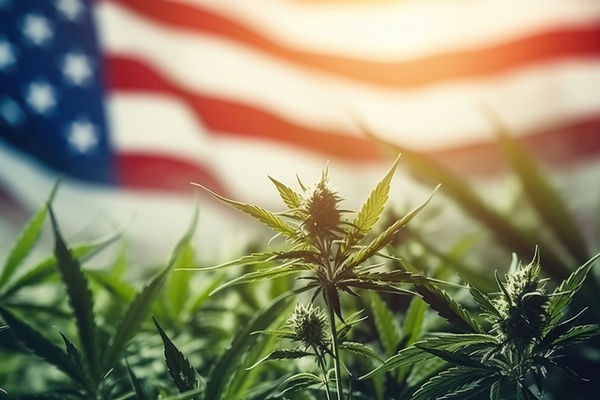Learn
History & Culture
Cannabis in America
History & Culture

Let’s set the record straight on one of the wildest flip-flops in American agricultural history: how a plant that helped build the nation—literally the ropes on Revolutionary War ships and the paper for the Declaration of Independence—ended up demonized and effectively outlawed by 1937. This isn’t just about “weed”; it’s about industrial hemp, the same species (Cannabis sativa), bred for fiber and seed. The story mixes patriotism, economics, racism, bureaucratic empire-building, and straight-up corporate greed. Buckle up.
Colonial Roots: Hemp as a Mandatory Cash Crop (1600s–1800s)
Hemp arrived with the first English settlers. In 1619, the Virginia House of Burgesses passed America’s first hemp law, requiring every farmer to grow it—fines or jail if you didn’t. Why? The British Navy needed miles of rope and sail canvas that only hemp could provide (one warship alone required 60–120 tons). Colonies like Massachusetts (1631) and Connecticut (1632) followed suit. Hemp was so vital it was legal tender in Virginia, Maryland, and Pennsylvania—you could pay taxes with it until the early 1800s.
Founding Fathers were all in:
-
George Washington grew hemp at Mount Vernon for decades (diary entries mention sowing seeds, separating male/female plants for better fiber, and experimenting with “Indian hemp” varieties). He wrote about wanting more hemp for national consumption.
-
Thomas Jefferson cultivated it at Monticello and Poplar Forest (using enslaved labor), invented a hemp brake to speed processing, smuggled premium seeds from China, and called hemp “of first necessity to the wealth & protection of the country.”
-
Benjamin Franklin owned one of America’s first hemp paper mills (used for anti-British pamphlets).
-
Others like John Adams and James Madison grew it too.
By the mid-1800s, U.S. hemp production peaked—Kentucky alone grew tens of thousands of acres for rope, sails, and bagging. It was patriotic, profitable, and everywhere.
The Slow Decline: Competition and Changing Times (Late 1800s–Early 1900s)
Hemp started fading naturally:
-
Cotton (cheaper, softer) replaced it for clothing.
-
Steamships needed less sail canvas.
-
Abaca (Manila hemp) and jute imports undercut prices.
-
Post-Civil War labor shortages (hemp processing was brutal manual work, often done by enslaved people) made it less viable.
By the early 1900s, U.S. hemp was a shadow of its former self—mostly imported fiber, small domestic crops in Kentucky/Wisconsin. New decorticating machines (separating fiber efficiently) promised a revival, but then... politics intervened.
Enter the Players: Racism, Bureaucracy, and Corporate Interests (1910s–1930s)
Recreational cannabis use trickled in via Mexican immigrants fleeing the 1910 Revolution. They brought the habit of smoking “marihuana” (the Spanish name, deliberately used to sound foreign). In the Southwest, anti-Mexican sentiment exploded during the Great Depression—blaming immigrants for jobs. Local papers ran scare stories: “marihuana” caused violence, insanity, “lust for blood.”
Jazz musicians (many Black) adopted it too, linking it to “degenerate” culture.
Prohibition’s end (1933) created a problem: thousands of alcohol agents needed new jobs. Enter Harry J. Anslinger, a ruthless Prohibition enforcer appointed in 1930 as first commissioner of the new Federal Bureau of Narcotics (FBN)—created when drug enforcement split from alcohol (now legal). Anslinger’s boss? Treasury Secretary Andrew Mellon (banker, DuPont investor). To justify his agency’s existence, Anslinger pivoted to marijuana.
Anslinger’s campaign was pure fearmongering:
-
He fed newspapers lurid tales (often fabricated) of axe murders, rape, and madness caused by “marihuana.”
-
Racist quotes: “Reefer makes darkies think they’re as good as white men”; linked it to “degenerate Spanish-speaking residents.”
-
Partnered with William Randolph Hearst, newspaper tycoon with vast timber holdings—Hearst’s papers blasted “marijuana” headlines to protect wood-pulp paper from cheap hemp alternatives.
-
DuPont (nylon patents in 1930s) feared hemp fiber/textiles; Mellon’s investments tied in.
The 1936 propaganda film Reefer Madness (funded indirectly via church groups Anslinger influenced) sealed the hysteria: teens smoke pot, go insane, commit murder/suicide.
The Nail in the Coffin: Marihuana Tax Act of 1937
Anslinger drafted the bill. Hearings lasted days but were a sham—AMA’s Dr. William Woodward called it baseless, but was shouted down. Passed as a “tax” (federal government couldn’t outright ban then), it imposed crippling registration fees and taxes on all cannabis transfers—medical, industrial, or recreational. Non-compliance? Felony.
Result: Hemp farming collapsed (too bureaucratic/expensive), recreational use criminalized. An industrious crop died not from science, but greed (protecting nylon, paper, petrochemicals) + racism + Anslinger’s empire-building.
Scholars agree: prohibition was rooted in prejudice and economics, not public health. (See Bonnie & Whitebread’s classic The Marijuana Conviction, 1974; recent works like Campos challenge over-emphasizing Mexican link but confirm racism’s role.)
Today’s revival (2018 Farm Bill) proves our ancestors were right: hemp’s a powerhouse. But the 1937 ban’s legacy—disproportionate arrests, especially communities of color—still lingers.
Basics & Fundamentals
History & Culture
Science & Research
Growing & Cultivation
All About Hemp
Consumption Methods
Sources for further reading.
Photo Credit: Oksana Smyshliaeva
